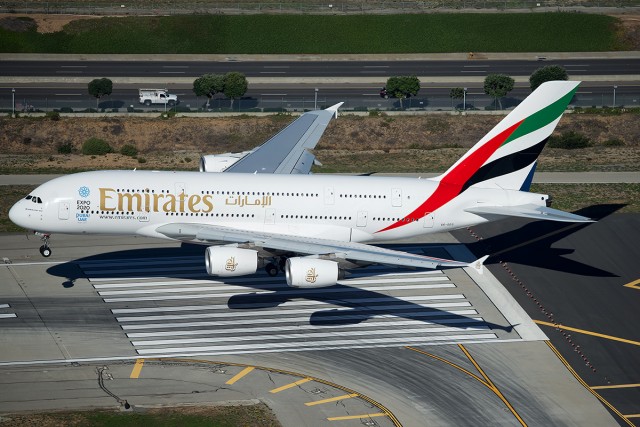
Anywhere from five to ten years from now, the A380 is going to get even better – Photo: Bernie Leighton | AirlineReporter
First things first; I am sick and tired of all the A380 hate. I get it; it’s not made by Boeing and doesn’t fit the U.S. major route network. Here’s the thing: that doesn’t make it a terrible aircraft and an absolute aviation sin.
I am tired of reading comments from people saying, “Since Delta never ordered it, it must be too big.” No one also wants to hear your comments about how the A380 only works for “government-subsidized airlines,” or, “how all the other airlines that operate it regret it.” I’m looking at you, Jeff Smisek.
There are two immediate things I’ve always thought were an issue with the A380…well, maybe two and a half. Things that I have wanted Airbus to fix for a while now. Let’s dive in…
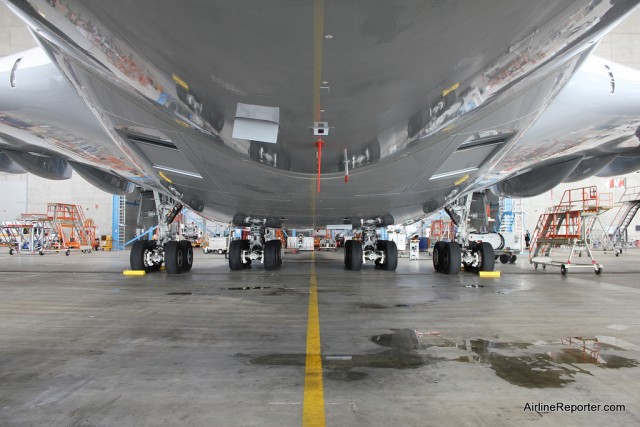
The underbelly of a Lufthansa A380 – Photo: David Parker Brown
Airbus A380 Fix Number One:
There is too much wing.
The A380-800 as we know it today was always designed to be the baby of the family. In the name of engineering, maintenance, and certification commonality, it was “over-winged” to meet the needs of any potential stretches that could fit within the 80m ICAO code-F parking space at any A380-compatible airport. Thing is, it was long suspected that both the A380 freighter (which was cancelled during the global financial crisis) and the undetermined-length stretched A380-900 would have a maximum take-off weight of 590,000kg (1.3 million pounds). This meant the A380’s wing chord was significantly beefed up to meet an additional 15,000kg demand that was never placed upon it.
An easy, but not cheap, solution: re-profile the wing. Cut the chord down to match the weight of the current needs of the ultra-long-haul A380 operators. Cutting the chord will change the span slightly, but changing the span means than rather than having old-style, but giant, wing-tip fences to fit within the Code-F box, you can add a modern A350-style sharklet.
These changes would not only save weight, they’d also reduce aerodynamic drag. Less aerodynamic drag equates to lower fuel burn. Lower fuel burn and less structural weight can lead to either lower unit cost, or longer range.
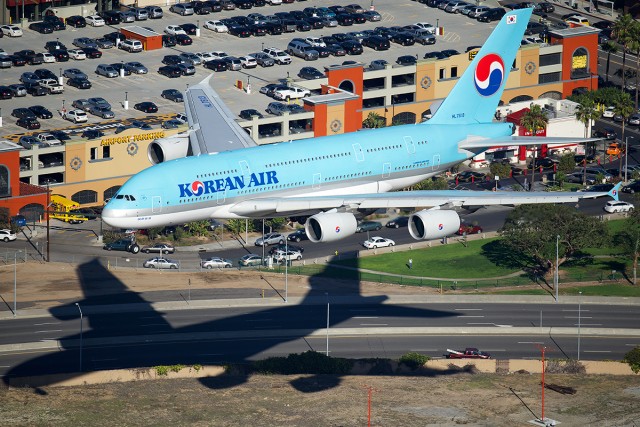
Such a thick wing chord for such a small plane. If only they could reprofile it. – Photo: Bernie Leighton | AirlineReporter
Even the older A380-842s operated by Qantas can operate Dallas-Ft. Worth to Sydney (with some payload restrictions). Now, imagine that route with no payload restriction?
This is not just about range. Reprofiling the wing and changing its tip device is about increasing payload and reducing operating cost.
It’s no wonder that Airbus has said that if their A380NEO arrives with an EIS of somewhere between 2020 and 2025, they will have done unspecified things to the wing. I suspect the above.
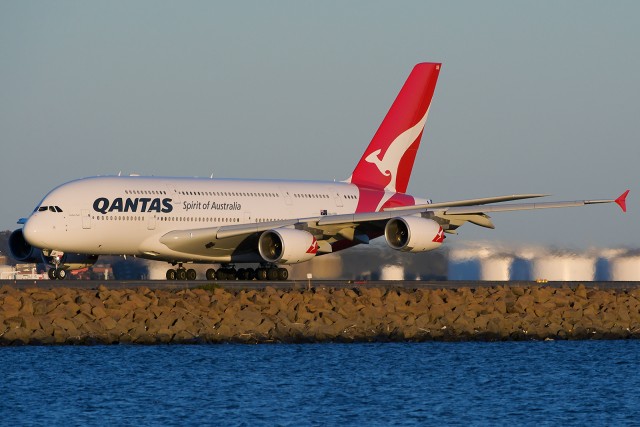
Qantas is the only Rolls Royce-powered A380 operator that performs ultra-long hauls with their frames – Photo: Bernie Leighton | AirlineReporter
Airbus A380 Fix Number Two:
To stretch or not to stretch?
Believe it or not, I think the A380NEO needs a stretch option. Not an extremely technical and expensive A380NEO/R option that can match the range of today’s A380-800. No, not at all. But a 10-frame stretch with no max gross weight changes would be beautiful.
Steven Udvar-Hazy, CEO of Air Lease Corporation, suggested this back around 2007 when the A380 was being introduced into service. An A380-900NEO of that length would allow a 600 or more passenger capacity in even a four-class configuration. That’s a serious contender for hub-to-hub flying, and there are routes that can sustain this. London-Mideastern Hub-Sydney instantly springs to mind. Obviously, it would not be a huge seller, but it would more than pay for its development cost in orders.
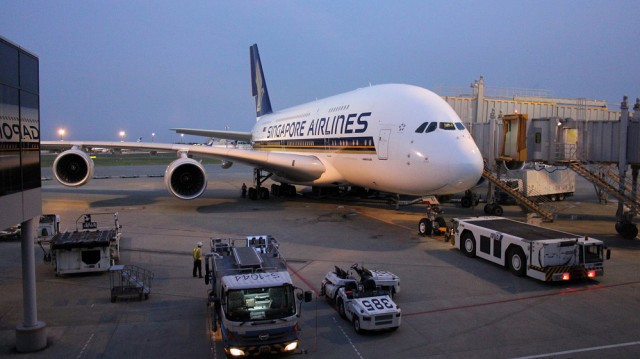
A Singapore Airlines A380 in Tokyo – Photo: David Parker Brown | AirlineReporter
Here’s where I think Airbus needs to do something a little different. Add at least a four frame stretch to the base model 800NEO. Range is not an issue for the current A380-800, but cargo capacity is. Extending the cargo hold forward or aft of the wingbox will make the airframe more competitive and the extra seats will lower unit cost.
Emirates, for instance, could configure a four-frame stretch 800NEO to seat 550, while still being able to fly Dubai-Los Angeles with full payload at a lower trip cost.
Even if there is an economic downturn between now and the EIS of the A380NEO between 2020 and 2025, that will not halt global economic growth and passenger demand for time immemorial there after. There needs to be more seats on this lighter NEO to get the unit cost down to either 777-9 levels or below. I think that it can be done.
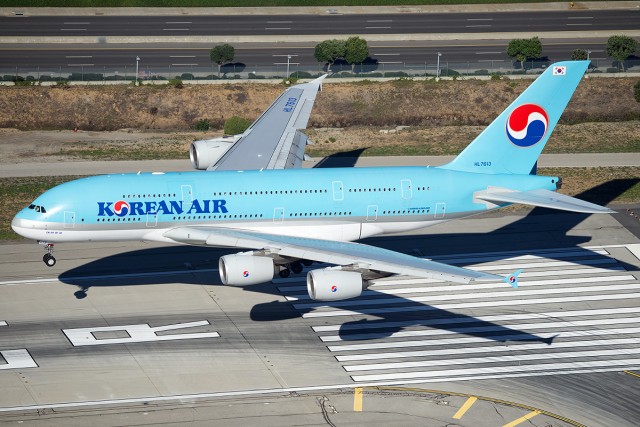
Imagine if you could add a few fuselage sections to the A380. It’d be better for everyone – Photo: Bernie Leighton | AirlineReporter
Airbus A380 Fix Number Three:
New engine?
Well, yes, of course. Airbus has said as much, and that it will be single-source.
How? Every oddly anti-Airbus person I know was cheering when the CEO of Rolls Royce said he didn’t see a market, nor wanted to spend a lot of money developing an engine for an A380NEO. Truth is, he never really said either.
If you actually read between the lines, he didn’t really say anything that would be construed as a comment other than, “If they are willing to pay, I guess?” A lovely and non-commital answer. Truth is, no one is going to do a 100% clean sheet engine until the major engine manufacturers can figure out how to scale geared turbofans to above ~30k pounds of thrust (let alone the 80k you would need to match the current max output of a Trent 900).
The best option for the sole-source engine would be something derived from the Rolls Royce Trent XWB. After all, the lowest-thrust Trent XWB slots nicely into the A380 thrust range as it is. With a new wing, it is less likely to need as much power on takeoff to hurl it into the air.
Though my dream would be a breakthrough in the Pratt & Whitney Purepower program that created an 80k pound geared turbofan. Can you imagine the saved fuel consumption? It would be amazing!
What Airline Would Take the A380NEO?
So who of the existing operators should buy this lighter, more efficient, and maybe larger A380?
Emirates, Etihad Airways, and Qatar Airways. By the time that the A380NEO EIS, they’ll need to replace their old A380-800s. Accounting for growth, that’s at least 200 frames right there. With Dubai World Central, hopefully, opening by then as Emirates’ super hub, Emirates could probably operate 200 on their own. Let’s look in more detail with each airline…
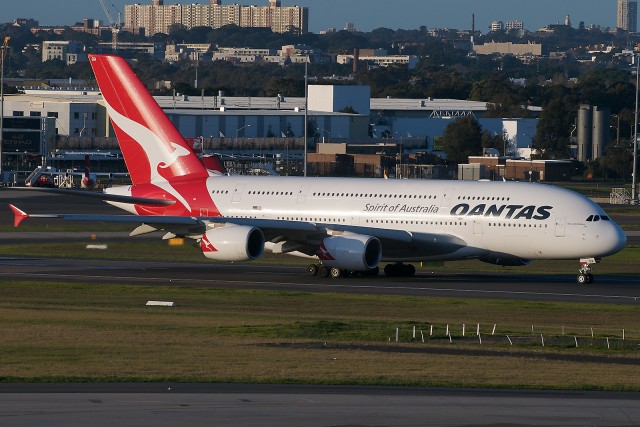
Qantas’ first A380-842 operating the now defunct QF31 service from Sydney – Photo: Bernie Leighton | AirlineReporter
Qantas: With the Emirates tie-up to the east and the American Airlines (pending) joint-venture to the West, plus throw in some absurdly long flights where frequency is obliterated by crazy time differences, and you need something big to meet future demand. True, Qantas deferred their last A380 tranche, but deferred is not canceled. Rationalize the A380 to serve merely Dubai, London, Hong Kong, Los Angeles, and Dallas with not a frame to spare and it makes sense to replace them. Lower fuel burn, greater payload.
Lufthansa: Replacement, maybe expansion, but my bet would be on replacement. There is a place for the A380 at Lufthansa, but it will not be used for anything radical.
British Airways: Simple really, Heathrow is not going to get any less crowded, and by 2025, their original A380s are not going to get any younger.
Korean and Asiana: They are both in the same amazing transfer hub of Incheon. Their small fleets will need replacing, maybe even expansion. The Korean economy is hot and those two airlines are forming a nice bridge across the Pacific from the Americas into Korea, Northern China, and the Russian Far East.
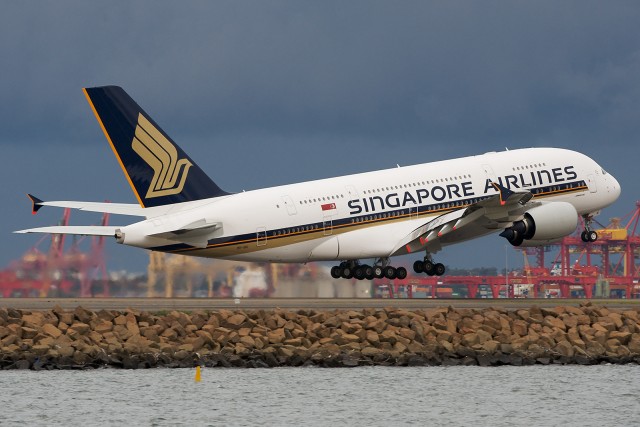
Singapore Airlines could benefit from a new engine option for the A380 – Photo: Bernie Leighton | AirlineReporter
Air France, Malaysia Airlines, Thai Airways International: I feel they all need help running an airline. By the time Malaysia Airlines relearns this art, they will have a new name and a regional niche.
Turkish: They do not have any yet, but they should. They’ll have a new super hub replacing the current manifestation IST. They have the end game of being a major connecting carrier, but they also deal extensively in passenger volume. Give them compelling operating economics, when they have an airport where they can fit their fleet at peak times, it’d be good for them. They could even fly it to their more popular European destinations on off-hours between long-haul flights.
Then you have China, which is a strange market. It’s growing ridiculously fast and its airports are starting to become the crowded ramp the A380 was designed for. As we all know, however, China has seemingly infinite money to spend on infrastructure. Crowded airport? Build another one! Just look at Beijing.
By 2025, it will have two giant international airports (Capital and Daxing). The state could either abandon the A380 in favor of filling its new super airports with hundreds of smaller twins, or just order dozens of A380NEOs and hundreds of twins — it will play out in a manner that befits the trade-surplus the central government wants to address.
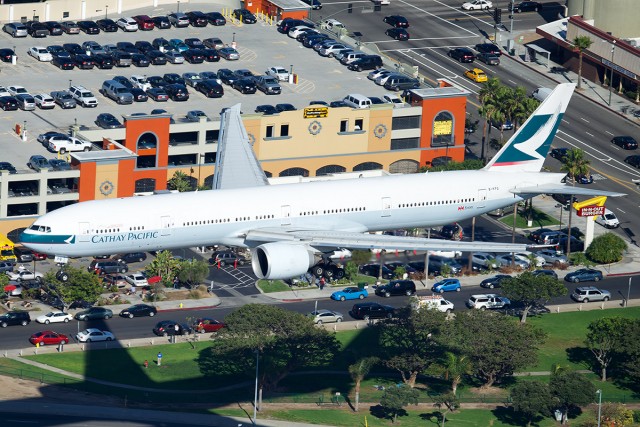
Cathay needs A380s in the future. Fuel is never going to be this cheap again and frequency achieves diminishing returns on ultra-long hauls – Photo: Bernie Leighton | AirlineReporter
Cathay Pacific: Hong Kong can only have so much land to park 777s around. Cathay Pacific has four flights a day to JFK, two of which arrive in New York within two hours of each other. Similar story for Los Angeles. They are not hurting on seat factors either. Now yes, the current A380 lacks the freight-train like capabilities that the 777-300ER can offer, but the NEO will offer lower unit cost as well as a more compelling belly-freight capacity. On top of this, frequency on ultra-long-haul flights works when fuel prices are low, but who is to say what a gallon of Jet-A will cost in 2025. As much as the airline dislikes the current A380, the NEO is a different beast. The 777-9 serves a great purpose, slight expansion in capacity on current 777 routes, but it does not solve the problems of crowded airspace and even-more-crowded airports.
Realistically, by the time the A380NEO enters into service, the global economy will be a completely different landscape. More people are going to be flying than ever, and airlines that make no sense as operators right now could easily grow into them.
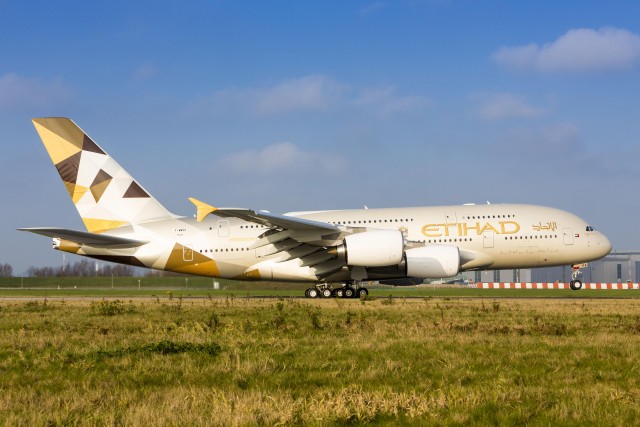
Excellent commentary which pairs well with rational thought. You did your homework and it shows. Great stuff, Bernie.
JL | AirlineReporter
Bernie you are a moron.
you missed the most important point -the airlines as well as airbus will lose there asses on this whale
Ordinarily I let negative comments slide. This time, however, I cannot as it seems immediately apparent you didn’t even read the article. Usually negative comments have a basis in something I said in the article. Not this time, it’d seem.
N.B. “I am tired of reading comments from people saying, ”Since Delta never ordered it, it must be too big.” No one also wants to hear your comments about how the A380 only works for ”government-subsidized airlines,” or, ”how all the other airlines that operate it regret it.” I”m looking at you, Jeff Smisek.”
If you are willing to call me a moron, I would have expected you to at least notice that I didn’t particularly care what the bombastic, usually American, anti-A380 camp had to say unless it had a strong basis in fact.
That did not.
Thank you for making yourself the goat.
– Bernie
Very well put, Bernie. Some people would descend into name calling and a verbal war….you maintain your professional decorum and don’t take a personal attack and knee jerk.
The mark of a true professional and a consummate professional.
Mr bernie it is the first time i comment on your site. I was and i still i am a bit one of those a380 haters. I think that the a380 for today market is too big. We should forget that we crossed i very bad recession and my country continues with capital controls exc so demand had slowed but it growing again so i believe that in 2016-2018 the opinion about the a380 will change positively.
Also the “it is too big” comment is been heard by other airlines
Moreover i believe that the following changes are important to make more attractive to airlines and throw off any remaining commetition
1. New engine favourably the advance ( i think that the gear system can not stand the friction and pressure of a engine over 50klb also i think they eet the bar too high for a 70:1 pressure ratio)
2. 20 foot stretch is needed. I runned some scenarios with difrent stretches and i discovered this will give most cargo capacity
3. A new wing made of aluminium lithium is the best solution as it will have lower production and servicing cost together with the weight savings of cnrp.
Wrbalaghogalogabuttfart, you are a limp dick.
You can start a debate without insulting someone.
I agree…there are fundamental issues in the basic A380 design that need some….let’s say “tweaking” (twirking an A380 is what would result from too little separation on the ground…) I have always felt the hate towards the A380 is not justified. Boeing ignored this market and then spews out a warmed over 747-8 to try and compete. The fact of the matter is that the A380 needs some definite refinement, a modest stretch and a more efficient powerplant. Once Airbus adapts the product to modern needs, I think the plane will have renewed market potential. The original A380 is a lot like the Hawker Siddely Trident in that it was built in many ways for certain major carriers and it has limited its appeal elsewhere. Airbus needs to have faith in the A380….aside from the massive losses if the program was terminated, I for one would be very disappointed. But I’m not buying an A380 and my perfect airline would be built around an all Airbus/Bombardier fleet…I firmly believe in the company and the product. Since I can’t have a fleet of L-1011s, A330s, A350s and the CSeries…
I do like the A380 and would like to fly on one.
However I just don’t see the market demand. Airbus still has the SkyMark white tails. Malaysian is trying to sell their slightly used A380’s and Swiss airlines is potentially going to have some coming off lease.
If Airbus can’t sell the white tails for a decent price and Malaysian can’t unload there’s for a good price and the Swiss ones end up going for poor prices, I just can’t see Airbus putting more money in this aircraft.
The question is: Is Airbus going to get a better return on investment by putting money in a A380 strech/NEO or using that money for an improved A320/A330/A350 or other project.
Well, as my engineer grandfather used to say….”Innovate or Perish”….the A320neo, A320neo and A350 are all doing well and the A380 has too much importance both as a business case to Airbus as well as the airlines that have purchased it. Don’t forget, Airbus had white tail A300s and people thought that it was a white elephant and it became a successful program. Even the DC-9 was a slow start early on and Douglas had white tails for a while. I think that Airbus needs to reevaluate the market, go to potential airlines like Delta, United, etc… and then work to define a stretched version that is better adapted to the needs of North American carriers. Offer a competitive lease program or provide a package of financial incentives to make it an appealing product. I think that Airbus fell into a trap of its own making by building g the planes for a relatively unknown carrier like Skymark. They were eager to make an A380 sale, needed to look good to investors and they jumped the gun.
I won’t give up on the A380…I think it has life left…and Airbus needs to realize that they need to stop blowing smoke up the industry’s behind and action a plan to give us a new A380 with a moderate stretch, more efficient engines and a price tag that is more competitive.
There’s no way you’re going to get a North American carrier to buy the A380, let alone if you stretch it. Same story with the 747-8. They’re too big in a market that’s increasingly spread out with revolutionary airplanes like the 787 and A350 that allow for flights like San Jose – Tokyo and Austin – London. Not to say it’s the same story across the globe, but that’s where a lot of major carriers have stated their preference, and putting frequency over capacity for both operational flexibility and to appeal to coveted business travelers. Airbus cannot realistically expect to burn more money updating an aircraft that isn’t selling, all the while lowering the sticker price and expect to stay in business. They should look to do small little updates like putting on sharklets and remodeling the interior to do please Emirates to the best of their ability, but stretches, engines, wings, it’s all a money pit with no return on capital in sight.
While I don’t hate the plane, I have never seen in person, I live in MSP. I would love to see first hand how they cater the beast. I spent many year in catering the biggest I ever did was a 747BBJ. (-400)
In an effort to be a little more civil than others and in the spirit of full disclosure, I’m not going to pretend that I’m the biggest A380 fan in the world. That said, you did mention some points that I had not previously considered so I thank you for that. However, they did not persuade me that the a NEO version of the A380 would be a success. The Gulf three would order them and I don’t think anyone is questioning that, but outside of the Gulf I’m not convinced of the market. Also, I understand you may not like what he said, but you cannot completely disregard what senior executives at some of the world’s largest airlines have said. Anderson has indirectly stated exactly what Smisek so lightly said last week.
You did a good job assessing the sources of fuel savings in an updated A380 and I don’t think most people would disagree with the significance of the update in relation to fuel use. The biggest problem remains the shear size of the airplane. It is not an airplane made for a cyclical business and even if you were able to lower trip costs enough to the point where it breaks even at a competitive seat count compared to the 777X, etc. But the amount of seats that would flood the market and the fare pressure that would ensue would be detrimental to a lot of airlines.
As I said earlier I agree that the Gulf three would buy a large chunk of an A380NEO, I also believe BA would buy a sizeable amount, but not nearly the size of what their 747-400 fleet was back in the day. Lufthansa might take a few, Air France even less, maybe a few to various Asian carriers but that’s about all I foresee. British Airways has to deal with congestion at Heathrow and additionally, BA has decided to work with the gulf carriers and has used all the seats they supply to their advantage, unlike LH and AF. They are learning the hard way what happens when supply outweighs demand. Same could be said of Qantas who put themselves in a hole after they went shopping for a flagship, not a profitable long-haul airplane. Malaysia (or whoever they end up as) can’t shed their 380s fast enough, and even at what was likely an unbeatable package to lease them, Turkish opted against it. That’s not to say things will stay exactly the same in 10 years, but I think it would be foolish to have the ‘build it and they will buy it’ attitude with a potential NEO variant after what a (financial) disaster the initial A380 has been. Filled with rosy projections (even Boeing’s was way too high) when the global economy crashed (which it tends to do every so often) airlines – with the exception of the Gulf carriers, setting aside US carriers’ claims of subsidies – found the A380 to be inflexible and generally lost a lot of money on it and it has impacted sales. Amedeo, who purchased 20 A380s a year and a half ago and whose CEO nearly promised he would get Delta to fly one, hasn’t found a single customer and Airbus has had to juggle deliveries so Amedeo wouldn’t be stuck with white tails.
I know there’s a ton there, and I could keep going, but I mainly wanted to show that there was at least one person who disagreed with the premise of an A380NEO who could present a counter instead of calling you a moron. The bottom line for me is this: They’ve sunk so much money that they’ll never get back from the A380 program, trying to extend its life just for the sake of Emirates and pride doesn’t make sense when they could invest that money into their current products, or come up with a larger A350 to counter the B777-9X.
The thing is, it’s not a binary situation. A so-called A350-1100 will happen. The thing is that the true twenty-first century plastic fantastics behave a lot less compellingly at the edges of the payload/range curve than a refreshed 777. To make an A350-1100 compete at the edges of the 777-9X curve- it would cost so much, it would practically be an entirely new program. Now, I am not saying that the A350-1100 (when it comes) will not be an extremely efficient ~430-450 seat passenger jet that can carry said load ~7200nm. The question is, what about further- and what about more passengers? To me, it’s always made more sense to just simple stretch the A350-1000 to make the A350-1100 and use it as a 787-10 crusher in terms of “flights up to eight hours.”
The A380 mistimed the market. The 747-8 didn’t sell for similar reasons.
That does not mean there is no market for VLAs.
Every year there are more and more routes where capacity and frequency are necessary. Eventually, it will stop making sense to fly two planes on 14 hour flights within two hours of each other. There is a market for both, and it is a much more compelling case to offer a family of aircraft that gets you up to above 500 seats for the customers that need it.
You can’t do both. Airbus isn’t a money tree. I strongly agree with what Airbus’ intent of an A350-1100 would be and your assessment of its range (although I think you overshot it on capacity). But the suggestion that Airbus can essentially refresh every family of aircraft and have any kind of financial sense is ludicrous. I think their decision on this will show whether management has finally decided to act as a business or whether it wants to go back to the old ways of putting pride first and build another unwanted airplane at great financial loss. I really hope they choose to go with the A350 and maybe do some small things (sharklets, reconfigure the cabin) to appease Emirates on the A380. With used A380s heading to the market in the coming years at rock bottom prices, airlines that want A380 capacity will pick up used ones instead of paying hundreds of millions for new ones. The capital cost savings will be significant enough to keep airlines from ordering pricy updated models in a time of low fuel prices (and if fuel goes up, you’ll want an A350/777/787 instead).
But even with all that, I think it’s safe to say that we won’t convince each other. My main point with the initial comment was as I said to show that there was at least one person who could respectfully disagree and present a counter instead of just calling you a moron.
“I think their decision on this will show whether management has finally decided to act as a business or whether it wants to go back to the old ways of putting pride first and build another unwanted airplane at great financial loss”.
Nonsense. The fact of the matter is that it’s the typical”patriotic” American who puts pride first and who tends to bash anything not built according to American “standards”. Claiming that Airbus’s old ways was to put pride first is just so mindbogglingly stupid, but it illustrates how the typical American not-invented-here syndrome led Boeing to seriously underestimate Airbus. Airbus was created in the late 1960s by the French and German governments in order to be able to compete with the American manufacturers. The company has been extremely successful, beyond the wildest dreams of the founders of the consortium.
To choose to ignore all the previous points I have made backing up that statement and instead just call me a “typical American” as a way to brush aside any criticism of the perfect Airbus is ignoring fact and causes you to be guilt of the same thing you accuse me of. I stated clearly in my first comment that I am not a big A380 fan and that I think the money that thus far has been undeniably wasted on this program (unless you can show me where the return on investment is) would have been much better spent making the A350 more competative at the top segment (-1000) as the base model (-900) is much stronger in sales than the former which is squeezed by the 787-10 and 777X (and this is all after the rousing success of the -800 which had to be replaced by the same program Airbus initially tried to call the A350). I want to see strong competition between aircraft manufactuers worldwide and the amazing aircraft that they produce, not to see them waste money on clearly unprofitable programs just for the sake of building something impressive to the aviation community (Concorde, A380). And to that point, I’m still skeptical about the 747-8, pending a total turnaround in the cargo market, and dumbfounded at the mismanagement of the 787 program which likely now means it won’t be profitable until the early/mid 2020s. Bottom line is this, I have made several factually based arguments over several posts and just because you don’t like the point I make it doesn’t mean you can deflect my entire argument by putting all of it under the “arrogant American” tent.
Great reading, as always, Bernie… I’m in two minds. I love flying on the A380, but I do despise it all the same! Go Boeing!
I really wanted to read your “pay” articles on the ULH options for my home carrier – Singapore Airlines….
I think the anti-A380 hate is quite easy to understand actually, out of purely aesthetic reasons. Reading between the lines, I suspect aviation enthusiasts, especially those used to decades of dominance by the 747, think the plane that holds the record for largest plane should not be an ugly, ungainly plane with massive wings that are clearly bigger than needed to lift a short stumpy body, and then outfitted with hilariously tiny wing-tip devices. The fact that the wing is too big for the body, as you mention, also means the ugliness was not necessary and indeed was anti-economical to begin with. Airbus could claim the nose had to be ugly for economics, but that would not explain the ungainly wing. The only explanation is that Airbus was overambitious in expecting rapid progression to stretched variants, a risk that many believe they thought they could afford because the company could survive even catastrophic failure with a multinational bailout by its major participating nations. It is the possibility that the A380 was born ugly for political reasons, when Airbus could have made something of the same size that was both aerodynamic and beautiful, that really rankles aviation enthusiasts.
What I’m most excited about is that if Airbus is occupied with an A380neo, it gives Boeing that much more time to really nail the NSA and finally give us a new 737/757 replacement.
A380neo and wing improvements – costs? $3-$4 billion.
Timeline: 2020 – 2025
NSA – costs? $15-$20 billion.
Timeline: 2025-2030
Conclusion: A380neo ++ will not put much of a constraint on Airbus in being able to go head-to-head with Boeing on a middle-of-the-market airplane.
The A380neo is always a good idea for someone.
If it is not good for Airbus then it would be good for the competition.
If it is not good for Boeing then it would be good for Airbus.
As far as I am concerned, in my opinion the A380 is just too big.
The fact Airbus over-engineered the aircraft for future variants is a bet on the VLA market which never really materialized. The financial investment in this egocentric engineering makes a breakeven point for Airbus difficult to achieve. Though neutral between Airbus and Boeing, both companies bet on capacity for international routes rather than frequency with their VLA variants and in the past few years order books for both companies show a misdirection in 4 engine VLA’s. Reliability in both the 777 and A330 programs shows the antiquated need for 4 engine VLAs and recent reconfiguration efforts to increase capacity within A380’s shows an economic reality not coming to fruition.
Bernie’s argument for the VLA is overcrowding at traditional international airports such as Heathrow, Hong Kong, JFK, etc. The real fact is A380’s create arrival and departure delays due to wake turbulence separation requirements. Airports not willing to expand for VLA’s will lose international flights to secondary airports which can be served by 787, 777, or A350 aircraft. This will increase frequency while maintaining a handle on capacity utilization. As a business traveler, time is money and frequency solves many issues on when I fly. Direct routes to my ultimate destination, not necessarily London, Dubai, or Hong Kong, creates valuable time factors the A380 or 747-800 cannot solve. Aircraft such as A350, 777, and 787 especially, create opportunities for expanded direct markets while maintaining long haul capabilities, increased frequency, fuel efficiency…..All 3 which are critical for commercial success.
Good try Bernie on the arguments to save the over-engineered, costly, non-efficient VLA’s. Let’s look at the order books in a couple years and see how your arguments hold up.
“The financial investment in this egocentric engineering makes a breakeven point for Airbus difficult to achieve.”
Egocentric? Americentric? Or just dumb? You’re obviously ignorant of the reasoning for Airbus to launch the A380.
–
http://www.economist.com/node/9944806
The design of any new airliner begins years before its first flight. Appropriately for a super-jumbo, the A380 has had a long gestation. Airbus began looking at the possibility of building a 600-800 seat aircraft in 1990. But two years later Daimler-Benz and British Aerospace, two of the partners in the Airbus consortium as it then was, pushed for co-operation with Boeing on what prosaically came to be known as a new Very Large Commercial Transport (VLCT). Both companies knew the risk of competing head-on over such a big new aircraft. An earlier battle between the McDonnell Douglas DC-10 and Lockheed’s L-1011 had weakened both firms and pushed Lockheed out of the commercial-aviation business entirely.
Jà¼rgen Thomas, a veteran German engineer appointed to lead the project and who became known as the father of the A380, remains convinced that Boeing was serious about the partnership. Others were less sure. The view that came to prevail within Airbus, particularly with its French chief executive at the time, Jean Pierson, was that the Americans wanted to string the talks out for as long as possible.
For one thing, Boeing was insistent on producing a plane substantially bigger than the 747, which would complement rather than replace it. For another, as long as there was no agreement on how to build the VLCT, Boeing could continue to milk its 747 monopoly. It is said to have used its estimated $30m profit per 747 to cut the price of its other jets, like the 737, which face direct competition from Airbus.
I seldom get to fly anywhere (economic reasons). I have a list of planes that I would like to fly on and the A380 is on that list. If money weren’t an issue I would reserve “The Apartment” on Etihad Airlines just to experience it.
I hope all aircraft manufacturers can find a nitch, be successful, and provide good paying jobs for their employees.
I agree that the A380 will play an important role in the next decade as more airlines want to fly to the big airports.
People are forgetting that yields and demand are higher for the “Right” time of day LH/ULH flights. I.e. Very few people want to fly the day flight between LHR and HKG, this flight is only sold as the other flights are full.
Choice of schedule works for Europe – America flights, but Europe – Asia not so much. This is where the 380 comes in lifting more at the right time of day.
Bernie – Great write up.
Btw, I pilot this aircraft and yes it is not pretty, but once you are inside it’s much better than a Boeing in every way. Just a shame it arrived on the scene as the world economy took a big hit.
Hopefully Airbus will see sense to update the aircraft in 5 years.
All the reasons why A380NEO is a bad idea can be found right here, and I agree with this argument much more than the one made by airlinereporter. Nothing personal at all, I am just much more convinced by skywriter in this case.
http://www.skywriteraviation.aero/2015/07/22/why-airbus-hasnt-launched-the-a380neo/
Skywriter, eh? LOL!
“Judson Rollins – Publisher & Chief Analyst: From 2011 to early 2015, Judson was a member of Boeing Commercial Airplanes” network and fleet planning team. At Boeing, he provided network- and revenue-based perspectives to sales campaigns and assisted airline customers around the world with strategies in his areas of expertise.”
I agree with Bernie Leighton that the bombastic, American-centric, anti-A380 camp sound like a broken record.
The thing that floors me the most is not the disagreement, I expected pretty much every American to disagree. I also expected them to be less vocal about it.
What shocked me is someone saying “Oh yeah, this article over here by some other guy is way better- you guys should just read that!”
Just strikes me as tactless to link to another article like that on someone else’s article. Implying and mentioning it is cool, but straight out saying “HEY! READ THIS INSTEAD!” Because you agree with it more… then having others agree with Skywriter’s article?
I had no idea that the A380 was so reviled that hijacking discussions and saying other arguments were “just more convincing” was considered within social norms!
Bernie i will disagree with you over the a380neo. To begin with you can do many things to make the a380 viable.I think the chord should stay the same because you need to stretch. I think a better idea is to replace the wing panels stringers and spars with cfrp this will save 6 tons. You can put a brand new wing modification new engines streched fuselage and many more. But the problem is that all these changes have some serious development costs. Just re-engine cost 2 billion if we include stretch and maybe wing modificication we hit 3-4 plus some overruns we talking about 5 billion easy. So what is the appeal of the a380 to the market.
Delta:It is too big
United:It is a product for state subsidized airlines.
Turkish:we need more frequency not capacity
Cathay: we need frequency and cargo capacity
Garuda: we couldn’t make it work.
TAM: No need at least until 2020-2025
British: Very good airraft but 12 are enough for us
Qantas:It is good but only in a very few routes looking to cancel the last 8 orders
Air france: the same
Singapore:We are noncommital we believe 10% is unrealistic we prefer a simple PIP
There is no demand for the airplane airlines say and airbus do like it doesn’t hear it.The problem is not only efficiency but capacity. This aircraft is too big for most routes, it is uneconomical to have a fleet of 4-6 aircraft so they do not move forward. Another important factor is that now airlines are trying to make profit so they choose to keep suplly low to keep prices. Yes i will agree with you that there is demand. I calculate around 275.
Emirates:200
Qatar:25
British:15
Etihad:10
Singapore:25
275 new orders are a nice number for the a380 but airbus has to make 18-20 million dollars in profit for each airplane it makes just to pay back its development cost for the neo. What i am trying to say is that the a380 has room for improvement. The problem is it economicalky viable to make such an investement. I really apreciate if you say your opinion on what i say.
Airbus could reduce the chord by the equivalent of one fuselage frame (25″ chord-wise) and reduce the root chord by taking out up to 10′ of the wing at the root – sort of opposite of what Boeing was planning to do with the 747X.
http://www.flightglobal.com/pdfarchive/view/2000/2000-1%20-%200204.html
Adding wing tip extensions and winglets – and/or folding wing tips – in order to regain the 79.75m wingspan (when parked), the “new” wing would have a reduced wing-area of more than 15 percent and a significantly better wing aspect ratio.
Thus, a smaller more optimised wing would be perfect for the A380-800 and even a shrunken version. Airbus could designate these two derivatives the A380-500X (i.e. same fuselage length as the A3XX-50/A380-700 originally conceived by Airbus), and the A380-600X (i.e. same fuselage length as the current A380-800). The current wing – upgraded with two 15′ folding wingtips would be perfect for the larger A380-900X and even an A380-1000X.
–
As for orders over a period of 10 years; Emirates could order as many as 400*, while the total demand could exceed 1000 units. An A380-600X would have about 30 percent less fuel burn per seat than the current A380-800; and that’s the clue to how you’d massively increase the demand for VLAs. If an A380-600X would resoundly beat the A350-1000/777-9X on fuel burn and CASM, then the market for the A380 would grow much faster than what would be the case if a simple A388neo is just beating the 777-9X by some 10 percent in fuel burn per seat. The larger A380-900X and A380-1000X would be even better CASM-wise, and they would both have impressively large lower decks as well (i.e. equaling or beating the A350-1000/777-9x on lower deck cargo carrying capacity).
Bernie, first of all, I was very careful to say that it wasn’t personal, that I was simply more convinced by the argument made on Skywriter. Second, I guess I could have pretended and taken credit for someone else’s argument. Third, I didn’t say it was better, I said I’m more convinced. You need to stop taking things personally, and take a chill. If you are going to post opinions then be prepared for people to disagree. Geez.
Airbus has sold zero A380s in the past 18 months. Used A380s are not selling, A380s bought by lessors are not selling. There is a limited market for this aircraft, throwing several billion in development for an aircraft you’ve lost your shirt on is a bad idea. Its not personal, its not Boeing Fanboys, its simply the argument against why Airbus should move forward.
Nothing personal, relax and have a beer or something.
Ok, so let’s revisit that Skywriter piece ……
Skywriter: Since its launch 15 years ago, the A380 has won just 317 orders versus the 1,200 Airbus projected in the program”s first 20 years.
That’s a lie**. The number 1200 was the Airbus forecast for the entire VLA market. Airbus has always set a targeted or assumed market share for the VLA market at 50 percent, thus targeting 600 A380 passenger aircraft on a 20-year forecast.
–
Skywriter: US airline CEOs have been particularly brutal in their public disdain for the A380. United CEO Jeff Smisek recently told a business travel magazine, ”That [A380] is a product for state-subsidized airlines, or airlines that have it and wish they didn”t.”
Who cares about what some US airline CEOs have to say about the A380? First, the US-3 operate from a multitude of hubs and where the A380 would be too big for the current markets. That doesn’t mean that in the future, the US-3 shouldn’t be able to utilise VLAs properly on selected routes as traffic increases.
BTW, it’s pretty hypocritical for Chapter-11 receivers to accuse others of being subsidised.
–
Skywriter: Open Skies disagreements notwithstanding, there”s also an issue of global airline capacity. As consultant George Hamlin pointed out in an Aviation Week column earlier this year, ”The European carriers, in particular Air France-KLM and Lufthansa, are probably close to apoplectic at the possibility of an A380neo.
George Hamlin? LOL
I”m sorry, but George Hamlin – another American “analyst” – lost any independent stature when he co-authored A Shadow Critical Project Appraisal: The A380 Program. It”s a Boeing sponsored FUD hit-piece on the A380 yet it doesn”t say so in the report. In fact, I don”t think too many people in the industry takes that report any more seriously than they would Randy Tinseth”s marketing blog.
https://s3-eu-west-1.amazonaws.com/rbi-blogs/wp-content/uploads/mt/flightglobalweb/blogs/flightblogger/050416-shadow.pdf
–
Skywriter: Airbus also regularly claims that the A380″s size allows operators to carry more premium-cabin seats, capturing additional revenue on long-haul routes where there are high levels of premium demand. But Delta”s Anderson effectively destroys this argument by pointing out premium customers” strong preference for schedule frequency: ”As a consumer, do you want eight flights a day in every time channel? Or do you want two a day, in two time channels where you take all four flights and pack them on an A380? It”s not what people want.”
Again, a typical Americentric point of view. The concept of frequencies on routes such as Asia to Europe flights, where the only ideal departure time is late night departure with a morning arrival, is really quite meaningless. I’m not surprised, therefore, that a big-mouthed CEO from a US airline chooses to gloss over the fact that frequencies are much less important on many an intercontinental route sector – i.e. routes not flown by any US airline – than on US domestic flights.
–
Conclusion: So, we’ve estalished to you’re more convinced by outright lying**; a “consultant” who’d apparently no qualms in putting his name on a Boeing-sponsored “report” that was nothing but a FUD hit-piece on the A380; the CEO from Delta who’s opinions are pretty much irrelevant to air travel outside the US – and last, but not the least; preferring an analysis from Judson Rollins — Publisher & Chief Analyst of Skywriter and who’s been a member of Boeing Commercial Airplanes” network and fleet planning team.
In short, it would seem as if you want to hear what you want to hear, however flawed an anti-A380 “analysis” might be.
Make that two beers.
Yeah, you’ve probably got to be intoxicated by alcohol in order to actually believe the BS from Skywriter. LOL!
Great read, and while I find the A380 and ugly plane and question the market behind it, this was a good case for how the A380 could have another 15 years of life.
Big missing item however was the used market. If Malaysia gets rid of its young A380s and no one buys them…how can you entice airlines to buy newer A380NEOs? Can they convert them to freighters on the second hand market? Does the economy still make sense for the Mid-East carriers if they essentially have a worthless plane after 15 years of flying/
My thoughts exactly. When basically every plane out there has multiyear waiting lists and brand new A380s can’t be sold, there’s something wrong.
Heck Boeing is even selling the 767. I think Airbus would be better off to just dump this aircraft or let it creep along at minimum production and see if in another ten years, someone want to order some.
TK, along with CX said that they prefer frequency as opposed to flying twice or thrice a day with 550 pax @ a time. I stand by the skywriter article.
“I stand by the skywriter article.”
Of course you do. LOL!
So when does the A380F go into production?
How about SQ in your opinion?
The “hate” on the A380 is not just irrational America first emotion. It really has no market if you go by recent sales. I love the 747 but its time has past also. No hate. Just facts.
True, the hatred of the A380 is not just irrational American first emotion, but the vast majority of these sentiments originate in the “land of the free”.
Mr berling i have a question. How big are the weight saving of thinnering the wing chord
replacing wing upper the skin pannels wing stringers and spars with aluminium lithium or carbon fibre will save 6 tons
For sure the A380 has its issues, but fly on it and you will be hooked……..if you look at some travel forums ( eg Business Traveller) you will see that people actively seek out the A380. Across BA for example on routes where there are multiple flights daily, eg LHR – IAD, people rearrange their schedules to go on the A380, because it is new, spacious, very comfortable and extremely quiet……..and that is on BA who have done absolutely nothing radical inside the aircraft. Yesterday, BA announced that they will schedule an A380 on to their Vancouver route and the positive feedback already is huge – Air Canada with their packed B777 will for sure soon notice the crowd pulling appeal of the big bird.
I have flown on BA A380 flights on 3 occasions with no complaints, but I had the chance to go business on Qatar’s and I have to say the stand up bar in the rear is like being in your local pub !
Given the right routes and favourable economics, this aircraft is a game changer………if Airbus keep the faith and the global economy plays its part, the A380 will still have a huge future.
PS – To prove I have no Airbus bias, Ihave also flown the Dreamliner on several occasions and think it too is a great aircraft and also a game changer, but in an entirely different game.
Future updates of the A380 need a redesign of the floor heights to maximise space on all three levels and the overhead bins need changes to make them more accessible and to accommodate more hand luggage.
I agree with the fact the A380,gets a lot of hate from the American airlines or carriers, but I also believe that the only way airbus can continue to exist is by revamping it’s larger sibling the A380, by creating a A380neo airbus will be providing something passengers will want to fly on and airlines like Emirates will find a joy to operate on the long haul sections of their flights.
The A380 does have a future, but only if it is modified to suit future growth a future proofed A380 would be a great thing not just for struggling airlines but also for the environment as less fuel burnt= cleaner air and less noise on take I was at the Farnborough airshow last year and saw the A380 performing some pretty amazing aerial manonovers and it was amazing.
I have also flown on a Singapore Airlines A380 from London-Hong Kong via Singapore in 2008 and can say its an amazing aircraft to fly on, but I can also see the potential this airliner would provide if made into a A380-900 or an A380neo bouth of which make sence as they are the way of the future and I can see why Emirates and Rolls Royce have been campaigning for one to airbus as specially given that the current version has had no new orders and is becoming a white elephant so to speak.
I firmly believe that it is in the interest of Airbus to re-design and upgrade the A380 program as it would be a great shame to see it become another of aviations forgotten or abandoned white elephants as specially as it has so much potential that is still left in it.
If airbus does take the decission to upgrade rather than abandon this program it would not only be a great decission but ultimately the right one to have made for everyone concerned as it would renew the jobs and lives of those who currently manufacture this technological marvel and giant of the skies for future generations to fly on and enjoy it as I did in 2008.
Facts:
A380 is a dream to fly on (in business class!)
All airlines are subsidized (state subsidies, chapter 11, lobbying pressure, national security)
A380 is probably a dinosaur – most people prefer point-to-point
Opinion:
Bernie likes to vent anti-American sentiment on this site (yawn…)
Why should Airbus throw more money down a rat hole?
Airbus is the best thing that ever happened to Boeing
If you you write an article stating controversial opinions . . . well someone might disagree with you!
Who really wants to stand in a security line or spend 30+ min on a train in a massive hub airport?
ur mom is a good idea
On the whole the idea of a new upgraded version of the A380 is a good idea not least because of the upgraded capacity for passengers & Freight and the very obvious increase in potential revenue for the any airline that buys them, what form it might take is a different proposition all together as a stretch would be great for the benefits I listed above.
a newly designed wing & better jet engines would give it more fuel efficiency and would provide it with more range there for more longer range non-stop routes would be a very real possibility for instance Santiago Chile to Inchon Korea or perhaps Anchorage Alaska to Auckland New Zealand or other ultra long haul routes that haven’t yet been flown to because of the sheer distances involved but if this becomes a reality records will be broken for the longest non-stop flights.
also since the A380 came into service in 2005 all the airlines that bought it have experienced an increase in the demand/amount of people who book flights just to be on-board one of these mega-liners of the sky and even though airbus is making newer twin engine airliners such as the A330neo/A350-1000 the fact is that airport congestion is still one of the biggest problems or headaches for airports around the world and the A380 is just one of many solutions that airliners have taken into account to deal with this ever increasing problem, if the A380 had not have been developed our airports would have become so overly packed or crowded that no-one would be able to fly at all come 2020.
the A380 is capable of seating up to a maximum total of 830 passengers in a all economy version as seen in the evacuation tests, although as of yet no airline has ordered any as the last one who seriously considered it as in Air Austral of the French reunion islands in 2005 but dropped it when they realised they did not need an aircraft with that sort of capacity.
Although I did hear recent rumors about Emirates was considering a two-class A380 seating up to 630 passengers and crew for it’s ultra high density routes out of Dubai, and Emirates was one of the airlines interested in a potential A380neo but what ever form the NEO takes I am sure that it would be a game-changer for the airline industry as a whole if airbus agreed to produce such a aircraft in the near future.
Very nice argument. I totally support the thing that you say “Realistically, by the time the A380NEO enters into service, the global economy will be a completely different landscape. More people are going to be flying than ever, and airlines that make no sense as operators right now could easily grow into them.”